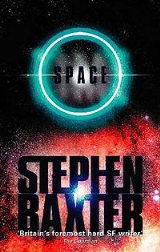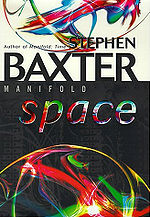
Manifold: Space
Encyclopedia

Science fiction
Science fiction is a genre of fiction dealing with imaginary but more or less plausible content such as future settings, futuristic science and technology, space travel, aliens, and paranormal abilities...
book by author Stephen Baxter
Stephen Baxter
Stephen Baxter is a prolific British hard science fiction author. He has degrees in mathematics and engineering.- Writing style :...
, first published in the United Kingdom
United Kingdom
The United Kingdom of Great Britain and Northern IrelandIn the United Kingdom and Dependencies, other languages have been officially recognised as legitimate autochthonous languages under the European Charter for Regional or Minority Languages...
in 2000, then released in the United States
United States
The United States of America is a federal constitutional republic comprising fifty states and a federal district...
in 2001. It is the second book of the Manifold
Manifold Trilogy
The Manifold Trilogy is a series of science fiction books by Stephen Baxter. It consists of three novels and an anthology of short stories relating to the three. The three books in the trilogy are not ordered chronologically; instead, they are thematically linked stories that take place in...
series and examines another possible solution to the Fermi paradox
Fermi paradox
The Fermi paradox is the apparent contradiction between high estimates of the probability of the existence of extraterrestrial civilizations and the lack of evidence for, or contact with, such civilizations....
. Although it is in no sense a sequel to the first book it contains a number of the same characters, notably Reid Malenfant, and similar artifacts. The Manifold series contains four books, Manifold: Time
Manifold: Time
Manifold: Time is a 1999 science fiction novel by Stephen Baxter. It is the first of Baxter's Manifold trilogy , although the books can be read in any order because the series takes place in a multiverse.The book was nominated for the 2000 Arthur C...
, Manifold: Space, Manifold: Origin
Manifold: Origin
Manifold: Origin is a science fiction novel by author Stephen Baxter from the Manifold Trilogy.This is the third installment in Stephen Baxter's Manifold trilogy. It sees Manifold regular Reid Malenfant and others once again dealing with possibilities of primate evolution in all forms and...
, and Manifold: Phase Space.
Plot summary
AlienExtraterrestrial life
Extraterrestrial life is defined as life that does not originate from Earth...
activity is discovered in a Kirkwood gap
Kirkwood gap
A Kirkwood gap is a gap or dip in the distribution of main-belt asteroids with semi-major axis , as seen in the histogram below...
; the aliens are identified as self-replicating machine
Self-replicating machine
A self-replicating machine is an artificial construct that is theoretically capable of autonomously manufacturing a copy of itself using raw materials taken from its environment, thus exhibiting self-replication in a way analogous to that found in nature. The concept of self-replicating machines...
s (von Neumann probe
Von Neumann probe
The idea of self-replicating spacecraft has been applied — in theory — to several distinct "tasks". The particular variant of this idea applied to the idea of space exploration is known as a von Neumann probe...
s). Their activity is potentially an immense threat, as Malenfant notes in an earlier speech: "A target system, we assume, is uninhabited. We can therefore program for massive and destructive exploitation of the system's resources, without restraint, by the probe
Von Neumann probe
The idea of self-replicating spacecraft has been applied — in theory — to several distinct "tasks". The particular variant of this idea applied to the idea of space exploration is known as a von Neumann probe...
. Such resources are useless for any other purpose, and are therefore economically free to us. And so we colonize, and build."
The self-replicating spacecraft are named Gaijin , after their discovery by a Japanese observer on the Moon. Malenfant travels in a prototype fusion engine to the Kirkwood Gap and discovers a interstellar teleportation device. His travels around the galaxy uncover information about the Fermi paradox (see below). At the same time, the story also follows the efforts of Humans on Earth and the eventual draining of the Earth's resources, making a move off-world necessary. At the same time small group of humans use anti-aging techniques and an alien form of interstellar teleportation
Teleportation
Teleportation is the fictional or imagined process by which matter is instantaneously transferred from one place to another.Teleportation may also refer to:*Quantum teleportation, a method of transmitting quantum data...
to "parachute" in on the changing solar system over many centuries.
Eventually, it is revealed that in this version of the Fermi paradox
Fermi paradox
The Fermi paradox is the apparent contradiction between high estimates of the probability of the existence of extraterrestrial civilizations and the lack of evidence for, or contact with, such civilizations....
, sentient
Sentience
Sentience is the ability to feel, perceive or be conscious, or to have subjective experiences. Eighteenth century philosophers used the concept to distinguish the ability to think from the ability to feel . In modern western philosophy, sentience is the ability to have sensations or experiences...
life is endemic throughout the universe; Humanity simply hadn't noticed it earlier because the universe destroys any race before it becomes advanced enough to develop a Type IV civilization
Kardashev scale
The Kardashev scale is a method of measuring an advanced civilization's level of technological advancement. The scale is only theoretical and in terms of an actual civilization highly speculative; however, it puts energy consumption of an entire civilization in a cosmic perspective. It was first...
. The story ends with Malenfant helping the Gaijin build a shield to prevent a pulsar
Pulsar
A pulsar is a highly magnetized, rotating neutron star that emits a beam of electromagnetic radiation. The radiation can only be observed when the beam of emission is pointing towards the Earth. This is called the lighthouse effect and gives rise to the pulsed nature that gives pulsars their name...
from sterilizing a large part of the galaxy. Although this project will not be completed before another predicted pulsar event wipes out all extant species, it is hoped to give the sentient aliens who develop from the aftermath of the coming extinction a better chance at long term survival.
Characters
- Reid Malenfant – The main protagonist in all four Manifold Books.
- Madeleine Meacher – Other main character, former pilotAviatorAn aviator is a person who flies an aircraft. The first recorded use of the term was in 1887, as a variation of 'aviation', from the Latin avis , coined in 1863 by G. de la Landelle in Aviation Ou Navigation Aérienne...
of the futuristic space vehicles. - Nemoto – Lunar Japanese woman who mysteriously lives for many centuries, guiding humanity against the 'alien threat'
- Cassiopeia – Malenfant's Gaijin companion in his explorations
Reception
Publishers WeeklyPublishers Weekly
Publishers Weekly, aka PW, is an American weekly trade news magazine targeted at publishers, librarians, booksellers and literary agents...
was positive in their review saying that "the novel covers far more territory, both in time and distance, than any one person could ever absorb is both a strength and a weakness; suspense is difficult to maintain over the course of centuries. While a large cast of characters helps generate this unwieldy scenario, only their scientific motivations are explored. Science itself is very clearly the star player on this stage. Nonetheless, this focus allows for an exceptionally intricate and original view of the future that both scientists and lay enthusiasts will enjoy." Jackie Cassada in her review for the Library Journal
Library Journal
Library Journal is a trade publication for librarians. It was founded in 1876 by Melvil Dewey . It reports news about the library world, emphasizing public libraries, and offers feature articles about aspects of professional practice...
said that Baxter "balances the individual stories of his human protagonists against the panoramic scale of his setting in a landmark work of cosmic speculation".
Awards
Manifold: Space was named by Library JournalLibrary Journal
Library Journal is a trade publication for librarians. It was founded in 1876 by Melvil Dewey . It reports news about the library world, emphasizing public libraries, and offers feature articles about aspects of professional practice...
as one of the best Science Fiction and Fantasy books of 2001.
Publication history
- 2000, UK, Voyager ISBN 0-00-225771-8, Pub date 6 October 2000, hardback
- 2001, USA, Del Rey Books ISBN 0-345-43077-8, Pub date ? February 2001, hardback
- 2002, USA, Del Rey Books ISBN 0-345-43078-6, Pub date ? January 2002, paperback

